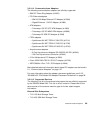
© Copyright IBM Corp. 1998 97
Chapter 4. Storage Architectures and Devices
In this chapter, the internal storage features of the Models 150 and 260 are
described. Storage standards, SCSI, and SSA are covered. The different
technologies are discussed, and additional information is provided in the
cabling sections. As well, a description of the storage devices and adapters
follows as well.
4.1 Storage Boot Devices
The system boot image can be executed from the following base storage
devices:
• SCSI CD-ROM
• SCSI DASD devices connected to a base SCSI controller
• SCSI tape drives
4.2 SCSI Overview
A Small Computer System Interface (SCSI) is a bus-level interface.
Computers may communicate with a large number of devices of different
types connected to the system unit through a SCSI controller and
daisy-chained cable. The attached devices include such peripherals as fixed
disks, CD-ROMs, printers, plotters, and scanners. The SCSI controller may
be in the form of an adapter, or may be integrated on the motherboard. There
are several terms and concepts used in discussing SCSI technology that
require definition.
4.2.1 SCSI-I
SCSI is a standard defined by the American National Standards Institute
(ANSI). The original SCSI standard is defined in ANSI standard X3.131-1986.
It defines an 8-bit interface with a burst-transfer rate of 5 MB/s and a 5 MHz
clock (1 byte transferred per clock cycle).
The American National Standards Institute (ANSI) refers to the different
SCSI specifications using the SCSI-I and SCSI-II type nomenclature. IBM
uses SCSI-1 and SCSI-2 nomenclature in official product names.
Note


















